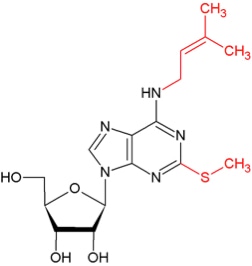
Isopentenyl adenosine is a member of the cytokinin family of plant hormones, which promote cell deivision by means of local and long distance signalling. Isopentenyl adenosine is abbreviated as iPA and the chemical molecular formula is C15H21N5O4.
Scientists at Creative Proteomics utilize a highly quantitative method with high-performance liquid chromatography (HPLC) for the determination of Isopentenyl adenosine levels in various samples, including Plant, Tissue and more. High-Performance Liquid Chromatography (HPLC) with UV detection is used for the determination of Isopentenyl adenosine (254 nm) levels in a lot of biological samples. This Methodology provides accurate, reliable, and reproducible results of Isopentenyl adenosine measurement, which enables us to analyze of Isopentenyl adenosine levels in vitro and in vivo.
Isopentenyl adenosine is a naturally occurring nucleoside with an isopentenyl moiety derived from the mevalonate pathway. Isopentenyl adenosine and its derivatives can be found next to the anticodon, which is at position 37 in tRNA and is highly conserved from both the Bacteria and Eucarya domains. These modified nucleosides can improve the translational efficiency of tRNA as well as increase and decrease translational fidelity and lead to make the tRNA less codon context sensitive.The biosynthesis of Isopentenyl adenosine and its derivatives seems to be linked to iron metabolism and central metabolic pathways in bacteria. Isopentenyl adenosine has a well-established anti-tumor activity. Isopentenyl adenosine also has the ability to selectively expand and directly target human NK cells. Isopentenyl adenosine can stimulate the resting human NK cells and synergize IL-2, which can induce a robust activation and significant secretion of CCL5 and CCL3 at submicromolar doses. In addition, Isopentenyl adenosine can promotes NK cell proliferation and up-regulates the expression of specific NK cell-activating receptors, just as the expression of CD69 and CD107a. Isopentenyl adenosine may represent a novel therapeutic perspective as an immune-modulatory drug.
The Russian-Polish botanist M. Tswett is generally recognized as the first person to establish the principles of chromatography. In a paper he presented in 1906, Tswett described how he filled a glass tube with chalk powder (CaCO3) and, by allowing an ether solution of chlorophyll to flow through the chalk, separated the chlorophyll into layers of different colors. He called this technique “chromatography”. Fundamentally, chromatography is a technique used to separate the components contained in a sample. High Performance Liquid Chromatography (HPLC) is a method able to separate non-volatile, thermally unstable, and polar components separate or in a mixture. HPLC is a type of chromatography that, because of its wide application range and quantitative accuracy, is regarded as an indispensable analytical technique, particularly in the field of organic chemistry. It is also widely used as a preparation technique for the isolation and purification of target components contained in mixtures.
Isopentenyl adenosine Analysis Service at Creative Proteomics supports your research in Isopentenyl adenosine Analysis. HPLC Based Analysis Service Platform enable us at Creative Proteomics offers you a state-of-the-art Analysis Service.
Sample Type
Plant, Tissue and more
Method
High-Performance Liquid Chromatography (HPLC) with UV detection is used for the determination of Isopentenyl adenosine (254 nm) levels in a lot of biological samples. This Methodology provides accurate, reliable, and reproducible results of Isopentenyl adenosine measurement, which enables us to analyze of Isopentenyl adenosine levels in vitro and in vivo.
Send us your samples, you will get all information that you need!







